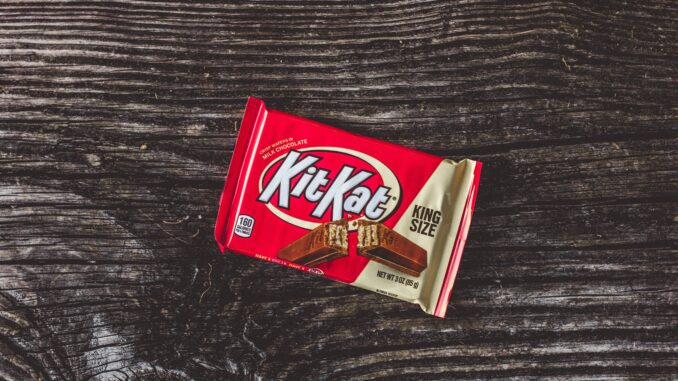
On every October 31st in the United States, New Zealand, and most of Europe, children go out, dressed up as their favorite football player, monster, or Disney princess to knock on people’s houses and say “Trick or Treat!” only to receive candy from these kind homeowners. As I grew up in Voorheesville, New York, I always loved the night of Halloween. I would meet up with my friends in costume, we would go from house to house, seeing how much candy we could get before people started to get angry because we were ringing their doorbell at 10 o’clock. Then we would gather up all our candy and compare and trade for our favorites, mine was a KitKat bar.
For as long as I could remember, the KitKat bar has always been my favorite candy, the chocolate outside and the vanilla wafer inside, it put two great things together to make a perfect combination. I loved its texture, the crunch it made as I bit down on it. The chocolate flavors mixing together with the crunchy texture to create a sweet and delicious bar. Once I discovered that there were other varieties like white chocolate, dark chocolate, and mixtures such as mint and dark chocolate, my passion only grew.
I started looking online on the Nestle store, looking for all the ways to eat and enjoy KitKats, which only led me down a rabbit hole even more. There, I discovered recipes for KitKat brownies, ice cream cake, cheesecake, tortes and more. My thirst for this pleasure was relentless and my appetite unending. What these discoveries have done to me may have steered my life in an upward spiral to more and more new ideas for my novice palate.
This newfound desire led me to try and go to the source itself and recreate my one and only necessity in this world. While trying to scour the web for Nestle’s secret formula, I stumbled upon something about how they were made. Thin sheets of vanilla wafer get funneled into a large oven to be baked to perfection. Then the wafer sheets are transported to an area where a layer of cocoa based syrup straight from Cote D’ivoire is poured, then another wafer is put on top of that, creating a sandwich of chocolate and wafer. It is replicated once more, and under extremely delicate procedures, sliced into their desired outcomes. They are finally coated in a special type of chocolate that was created to be cooled down and shaped into a perfect sized bar. To create these rectangle masterpieces, I realized I must research the sources, which lead me to learn more about their cocoa production in the beautiful Cote D’ivoire.
Upon researching the suppliers to Nestle, the Cote D’ivoire stood out to me. As in July 2022, Nestle retracted from their Fair Trade policy and changed it to a ‘Sustainability Differential’ policy. This at first, doesn’t seem like too big of a deal, but as I looked further into it, there is quite a big difference. Fairtrade policy is one that the Cote D’ivoire cocoa farmers have always been thankful for, as in recent times, there’s been a price collapse in cocoa. This has spelled disaster to many of the farmers, as the average cocoa farmer makes only $2.40 a day. But thanks to the Fairtrade policy that was in place, many of these Cote D’ivoire farmers have had some safety during this fall in prices. However, because of Nestle’s change to the ‘Sustainability Differential’ policy, the farmers are not paid the same premium as the Fairtrade policy agreement had given them.
This follows the trend in the past couple years, where companies like Sainsbury’s, Cadbury, and Tesco all canceled their agreement with Fair Trade as well. But this isn’t the only ethical problem that Nestle has had in the recent past. It has been subject to arguments over false advertising, where it aggressively stated that its formula for babies is better than breastfeeding, which had caused many infants to die unnecessarily. Along with other issues that have come up regarding taking Native American’s water from its already scarce quantity due to droughts in recent years is, “to act beyond the boundaries of ecological protection and basic human dignity”.
All these arguments have led to a rather uncomfortable question: should we be buying from unethical companies for our gustatory pleasure? Although these companies have done these arguably unethical actions, is there anything that can be done about it and can people like us put a stop to it? After looking at all these facts and having a long discussion with my stomach and tongue about this, I personally have come to the conclusion that I will stop buying from these companies that engage in unethical activities regarding their suppliers and others around them. I hope that whoever reads this can also think to themselves before making the choice of whether to get sick from the candy that is given out in copious quantities this year, and make the decision for themselves to refuse to take candies that are not ethically sourced.
